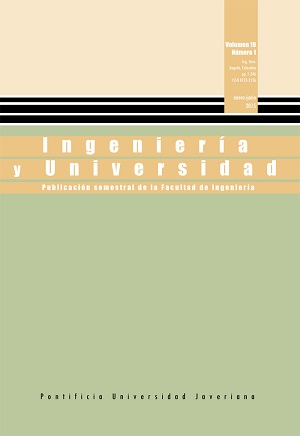Abstract
This paper presents an embedded system that detects inreal time the movement intention to control a prosthetichand. This work shows that using temporal characteristicsof simple calculation; it is possible to obtain subsets offeature vectors discernible enough as to use simple patternclassifiers. Thus, in this paper a classifier is proposed whichis based on the minimum distance from the centroid ofthe groups characterizing the movements to identify,modifying the known algorithm K-nearest neighbors.Movement intention classification results obtained fromthe developed system are shown; using the percentageof success as an effectiveness measurement, by conductingtests over three persons with healthy muscles. Theexperimental results show that this system can be usedeffectively for the control of execution of four motorprimitives on a prosthetic robotic hand.
[2] RSLSteeper. (s. f.). [En línea]. Disponible en: http://es.bebionic.com/the_hand.
[3] C. Cipriani et al., “The effects of weight and inertia of the prosthesis on the Sensitivity of EMG pattern recognition in relax state,” Journal Prosthetics Orthotics, vol. 24, no. 2, pp. 86-92, 2012.
[4] K. Ernest, S. Erik y E. Kevin, “Combined surface and intramuscular EMG for improved real-time myoelectric control performance,” Biomedical Sigmal Processing Control, vol. 10, pp. 102-107, mar. 2014.
[5] K. Englehart y B. Hudgins, “A robust, real-time control scheme for multifunction myoelectric control,” IEEE Transactions Biomedical Engineering, vol. 50, pp.848-854, jul. 2003.
[6] E. N. Kamavuako et al., “Estimation of grasping force from features of intramuscular EMG signals with mirrored bilateral training,” Annals Biomedical Engineering, vol. 40, pp. 648-656, mar. 2012.
[7] R. Clement, K. Bugler y C. Oliver, “Bionic prosthetic hands: A review of present technology and future aspirations,” The Surgeon, vol. 9, no. 6, pp. 336-340, 2011.
[8] A. Phinyomark, C. Limsakul y P. Phukpattaranot, “A novel feature extraction for robust EMG pattern recognition,” Journal Computing, vol. 1, no. 1, pp. 71-80, dic. 2009.
[9] A. Phinyomark et al., “EMG feature evaluation for improving myoelectric pattern recognition robustness,” Expert Systems Applications, vol. 40, no. 12, pp. 4832-4840, sep. 2013.
[10] E. Shroffe y P. Manimegalai, “Hand gesture recognition based on EMG signal using ANN,” International Journal Computer Application, vol. 2, no. 3, pp. 31-39, abr. 2013.
[11] S. Herle et al., “Myoelectric control strategies for a human upper limb prosthesis,” Journal Control Engineering Applied Informatics, vol. 14, no. 1, pp. 58-66, 2012.
[12] M. Khezri y M, Jahed. (Dic. 2007). “Real-time intelligent pattern recognition algorithm for surface EMG signals,” BioMedical Engineering. [En línea]. Disponible en: http://www.biomedical-engineering-online.com/content/6/1/45.
[13] A. Alkan y M. Günay, “Identification of EMG signals using discriminant analysis and SVM classifier”. Expert System Applications, vol. 39, no. 1, pp. 44-47, 2012.
[14] A. Subasi, “Classification of EMG signals using PSO optimized SVM for diagnosis of neuromuscular disorders,” Computers Biology Medicine, vol. 43, no. 5, pp. 576-586, jun. 2013.
[15] R. Richard et al., “Towards sEMG classification based on Bayesian and k-NN to control a prosthetic hand,” Biosignals Biorobotics Conference, pp. 1-6, feb. 2013.
[16] P. Parker, K. Englehart y B. Hudgins, “Myoelectric signal processing for control of powered limb prostheses,” Journal Electromyography Kinesiology, vol. 16, no. 6, pp. 541-548, dic. 2006.
[17] N. Jiang, K. Englehart y P. Parker, “Extracting simultaneous and proportional neural control information for Multiple-DOF prostheses from the surface electromyographic signal,” IEEE Transactions Biomedical Engineering, vol. 56, no. 4, pp. 1070-1080, abr. 2009.
[18] C. Cipriani et al. “Online myoelectric control of a dexterous hand prosthesis by transradial amputees”, IEEE Transactions Neural Systems Rehabilitation Engineering, vol. 19, no. 3, pp. 260-270, jun. 2011.
[19] F. Tenore et al., “Decoding of individuated finger movements using surface electromyography,” IEEE Transactions Biomedical Engineering, vol. 56, no. 5, pp. 1427-1434, may. 2009.
[20] C. Quinayás et al., “Diseño y construcción de la prótesis robótica de mano UC-1,” Ingeniería Universidad, vol.14, no. 2, pp. 223-237, 2010.
[21] R. Merletti y P. Parker. Electromyography: physiology, engineering and noninvasive applications. Wiley Online Library, 2005.
[22] K. Kim et al., “Comparison of K-nearest neighbor, quadratic discriminant and linear discriminant analysis in classification of electromyogram signals based on the wrist-motion directions,” Current Applied Physics, vol. 11, no. 3, pp. 740-745, may. 2011.
[23] C. D. Katsis et al., “A novel method for automated EMG decomposition and MUAP classification,” Artificial Intelligence Medicine, vol. 37, no. 1, pp. 55-64, may. 2006.
[24] A. Ajibove y R. Weir, “A heuristic fuzzy logic approach to EMG pattern recognition for multifunctional prosthesis control,” IEEE Transaction Neural System Rehabilitation Engineering, vol. 13, no. 3, pp. 280-291, sep. 2005.
[25] M. Okamoto y Y. Matsubara, “EMG pattern classification using hierarchical network based on boosting approach,” International Journal Innovative Computing, Information Control, vol. 5, no. 12(B), pp. 4935-4943, dic. 2009.
This journal is registered under a Creative Commons Attribution 4.0 International Public License. Thus, this work may be reproduced, distributed, and publicly shared in digital format, as long as the names of the authors and Pontificia Universidad Javeriana are acknowledged. Others are allowed to quote, adapt, transform, auto-archive, republish, and create based on this material, for any purpose (even commercial ones), provided the authorship is duly acknowledged, a link to the original work is provided, and it is specified if changes have been made. Pontificia Universidad Javeriana does not hold the rights of published works and the authors are solely responsible for the contents of their works; they keep the moral, intellectual, privacy, and publicity rights.
Approving the intervention of the work (review, copy-editing, translation, layout) and the following outreach, are granted through an use license and not through an assignment of rights. This means the journal and Pontificia Universidad Javeriana cannot be held responsible for any ethical malpractice by the authors. As a consequence of the protection granted by the use license, the journal is not required to publish recantations or modify information already published, unless the errata stems from the editorial management process. Publishing contents in this journal does not generate royalties for contributors.


